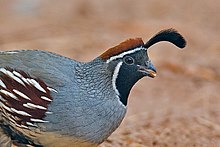Toothed quail
| Toothed quail | ||||||||
|---|---|---|---|---|---|---|---|---|

Crested quail ( Callipepla californica ) |
||||||||
| Systematics | ||||||||
|
||||||||
| Scientific name | ||||||||
| Odontophoridae | ||||||||
| Gould , 1844 |

The toothed quail (Odontophoridae) are a family in North and South America, as well as with two species of chicken birds (Galliformes) also native to Central Africa . The representatives of this family resemble the Old World partridges and quail , with which they are only distantly related.
features
Toothed quail have a typical chicken-like shape. They are stocky , short-necked, short-legged, short-beaked and mostly also short-tailed (exception: Dendrortyx ). In terms of shape, they are very similar to the partridges and quail and are also between them in size; this ranges from 17 cm (long-legged quail) to 37 cm (long-tailed quail).
It is named after the slightly serrated beak, a feature that can only be recognized from close range. The heads and hoods found in many species are more noticeable. The color mostly consists of brown and gray tones that allow camouflage in the undergrowth. Some species are more colorful, especially the facial area can be brightly colored. A sexual dimorphism is always present, but never as severe as in many species of the ancient pheasant-like : It consists in the males being somewhat larger, stronger colors and - if present - larger hoods and heads.
The short legs are sturdy and enable a long walk on the ground. In contrast to the pheasant-like, they do not have spores. The foot is anisodactyl . Like most chicken birds, toothed quails are reluctant to fly and only fly very short distances. A stretch from the ground to a branch or vice versa is often all that the wings are needed for.
distribution and habitat
Toothed quail are common in the Americas and in Central Africa. The distribution area in the New World stretches from the north of the USA to the south of Brazil and Paraguay . The greatest biodiversity is found in the tropics and subtropics. The affiliation of the two African species (subfamily Ptilopachinae), originally counted as pheasant-like, to the toothed quail has only recently been established.
Introduced by humans, there are tooth quails on other continents and on islands where they did not appear before. Both the crested quail and the Virginia quail were introduced to New Zealand and Hawaii , and the crested quail to Argentina and Chile . The South American crested quail was brought to numerous islands in the Caribbean. Humans have also expanded their range within America: for example, the Virginia quail, a bird originally only native to the east of the USA, was also made at home along the North American west coast.
Most species are habitats in forests, especially tropical rainforests . The more well-known species can also be found in more open habitats. The Virginia quail , for example, benefited from deforestation because it prefers open fields. The crested quail can be found even in deserts.
Way of life
activity
Toothed quails are diurnal ground dwellers who usually only seek higher places such as branches when fleeing from enemies. However, some species sleep in trees. Outside the breeding season, they live in large groups that can sometimes contain up to 1000 individuals.
food
As with many other chickens, toothed quail are insectivores in the first weeks of life, whereas as adult birds they are mainly herbivores. However, they remain pronounced generalists who eat numerous plant materials (seeds, leaves, buds, roots) as well as insects as complementary foods. Some species have particularly long toes that help dig into the ground; in this way they dig up plant roots.
Reproduction
Toothed quail are monogamous . A hollow lined with plant material serves as a nest, which is created in the dense vegetation. The clutches of the South American species usually contain three to six eggs, but the North American species in particular have extremely large clutches with up to 15 eggs. Since some species (e.g. Virginia quail) have brood parasitism within the species, i. H. Females lay their eggs in the nests of conspecifics, the clutch numbers per female are probably lower. The male is involved in the brood and sometimes also in the rearing of young - a behavior that is rare among chickens.
Because of the large number of enemies, toothed quail have a short life expectancy. It is estimated that few live to be more than a year old.
Tribal history
The oldest evidence of toothed quail is 37 million years old and comes from the Oligocene of Canada. There are numerous fossil finds from the subsequent epochs of the Miocene , Pliocene and Pleistocene . The recent genus Cyrtonyx is already fossilized from the Miocene, the genera Callipepla and Colinus from the Pliocene.
Not even fossil quail were ever found outside of America. The assignment of the genus Palaeortyx (Oligocene Europe) to the toothed quail was a mistake.
Systematics
External system
In the past, toothed quail were placed because of their great resemblance to the partridges and quail like this to the pheasant-like . Grzimek's animal life even places them as a tribe in the subfamily of the partridge on the same level as partridge-like and quail. Today, thanks mainly to molecular genetic studies, it is certain that pheasant-like and toothed quail developed independently of one another. The relative position of the tooth quail to the pheasant-like remains unclear.
Internal system
The following genera and species are assigned to the tooth quail:
- Subfamily Odontophorinae
-
Callipepla
- Douglas quail ( Callipepla douglasii ), northwestern Mexico
- Helmet Quail ( Callipepla gambelii ), southwest USA , northwest Mexico
- Crested Quail ( Callipepla californica ), western North America from Washington to Baja California
- Scaled Quail ( Callipepla squamata ), southern USA, northern Mexico
-
Colinus
- Virginia quail ( Colinus virginianus ), eastern USA, eastern and southern Mexico, Cuba
- Black-throated quail ( Colinus nigrogularis ), Central America from Chiapas to Nicaragua
- Spotted quail ( Colinus leucopogon ), Central America from Guatemala to Costa Rica
- Crested quail ( Colinus cristatus ), Panama , Colombia , Venezuela
-
Cyrtonyx
- Montezuma Quail ( Cyrtonyx montezumae ), Southwestern USA, Mexico
- Tear quail ( Cyrtonyx ocellatus ), Central America from Chiapas to Nicaragua
-
Dactylortyx
- Song quail ( Dactylortyx thoracicus ), Central Mexico to Honduras
-
Dendrortyx
- Bearded Quail ( Dendrortyx barbatus ), Hidalgo
- Guatemala quail ( Dendrortyx leucophrys ), Central America from Chiapas to Costa Rica
- Long-tailed quail ( Dendrortyx macroura ), central and southern Mexico
-
Odontophorus
- Capueira quail ( Odontophorus capueira ), eastern Brazil , Paraguay
- Chestnut Quail ( Odontophorus hyperythrus ), Colombia
- Collared quail ( Odontophorus strophium ), Colombia
- Marble Quail ( Odontophorus gujanensis ), Costa Rica, Panama, northern South America
- Red-breasted quail ( Odontophorus speciosus ), Ecuador , Peru , Bolivia
- Red-fronted quail ( Odontophorus erythrops ), Colombia, Ecuador
- Black-eared quail ( Odontophorus melanotis ), Central America from Honduras to Panama
- Black- backed quail ( Odontophorus melanonotus ), Colombia, Ecuador
- Black- fronted quail ( Odontophorus atrifrons ), Colombia, Venezuela
- Stripe- faced quail ( Odontophorus balliviani ), Peru, Bolivia
- Star quail ( Odontophorus stellatus ), Peru, Bolivia, Western Brazil
- Tacarcuna Quail ( Odontophorus dialeucos ), Panama, Colombia
- Drop quail ( Odontophorus guttatus ), southern Mexico to Panama
- Venezuela quail ( Odontophorus columbianus ), Venezuela
- White-throated quail ( Odontophorus leucolaemus ), Costa Rica, Panama
-
Oreortyx
- Mountain quail ( Oreortyx pictus ), North American west coast from Washington to Baja California
-
Philortyx
- Banded quail ( Philortyx fasciatus ), southwestern Mexico
-
Rhynchortyx
- Long-legged quail ( Rhynchortyx cinctus ), Honduras to Ecuador
-
Callipepla
- Subfamily Ptilopachinae
-
Ptilopachus
- Nahanfrankolin ( Ptilopachus nahani ), Eastern Democratic Republic of the Congo
- Rock partridge ( Ptilopachus petrosus ), Central Africa
-
Ptilopachus
Humans and toothed quail
The toothed quail played a role for the Indian population, especially as game. With the arrival of the whites, they began to hunt the chicken too. Today 20 million Virginia quails are shot annually in the US - yet the population of this common bird is secure. Deforestation in North America's forests may have benefited this species as it is most common in open fields.
The settlers named the birds after the models known from Europe. They are called quails (quails) in English and perdices (partridges) in Spanish . The latter name is also used in South America for the cockroaches , which are not at all related .
Sources and further information
Sources cited
Most of the information in this article has been taken from the sources given under literature; the following sources are also cited:
- ↑ a b Rauri CK Bowie, Callan Cohen & Timothy M. Crowe. 2013. Ptilopachinae: a new subfamily of the Odontophoridae (Aves: Galliformes). Zootaxa . 3670 (1): 097-098. PDF
- ↑ Gerald Mayr: The Paleogene fossil record of birds in Europe . In: Biological Reviews 2005, No. 80, pp. 515-542
- ↑ Bernhard Grzimek (Ed.): Grzimeks Tierleben , Volume 7/8: Vögel 1/2 . dtv-Verlag, 1979
literature
- Josep del Hoyo et al .: Handbook of the Birds of the World. , Volume 2: New World Vultures to Guinea Fowl. Lynx Edicions, 1994, ISBN 84-87334-15-6 .



